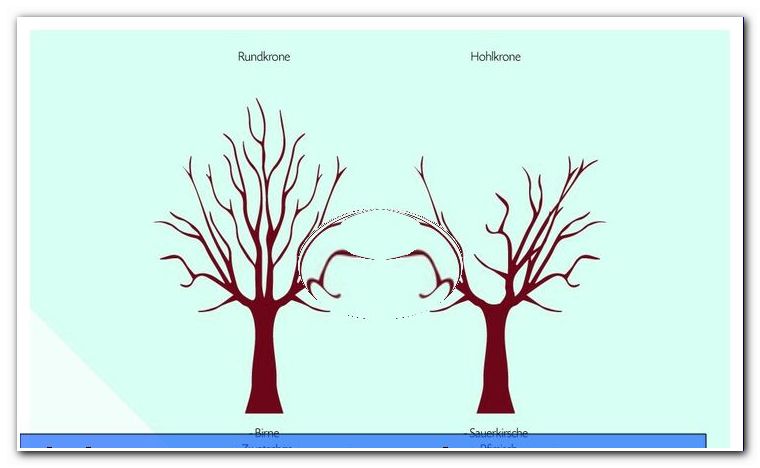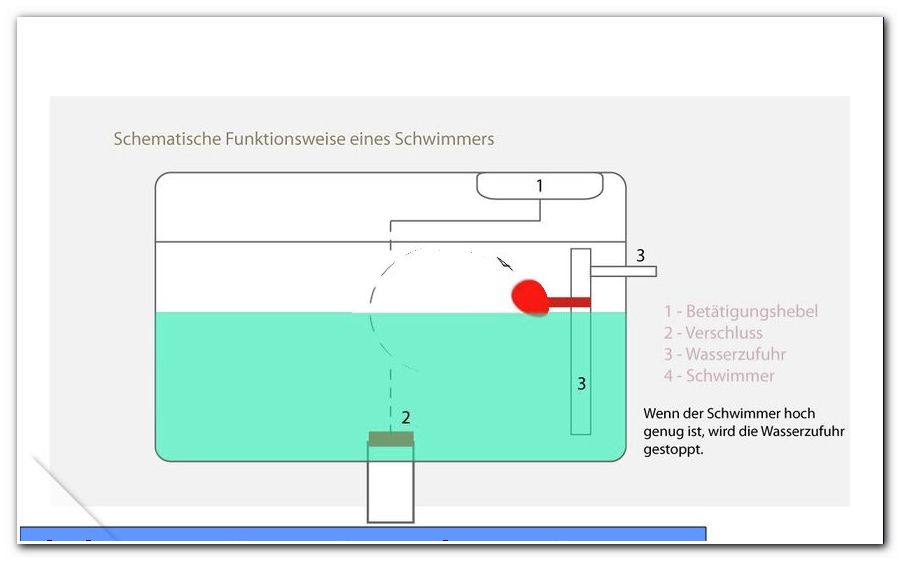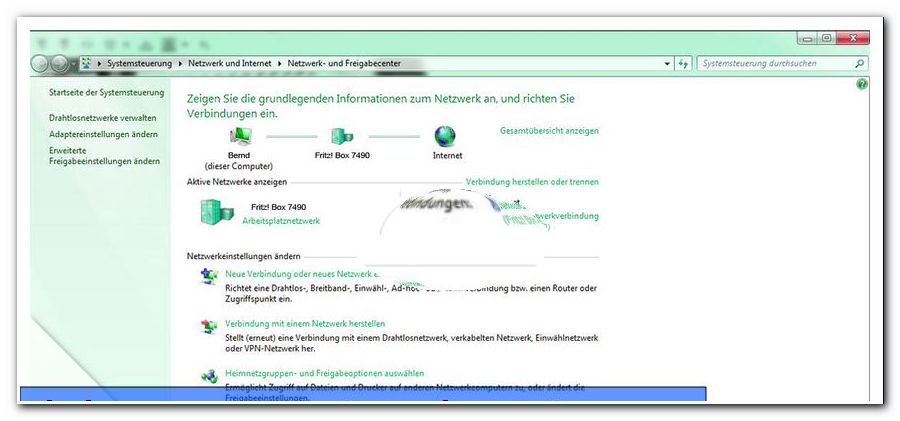Cutting fruit trees - that's how fruit tree trimming succeeds
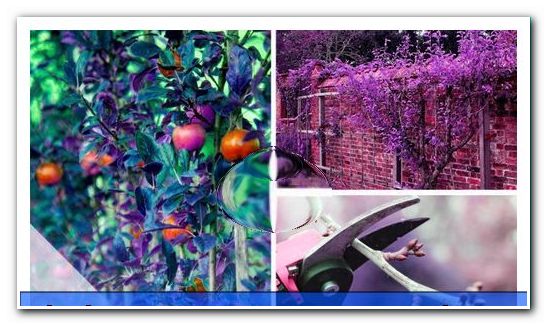
- The right cutting technique
- The right cutting time
- Shearing tools
- The age appropriate cut
- plant section
- education section
- preservation section
- rejuvenation pruning
- Different cuts
- incision
- Crown shapes in fruit trees
- Round crown Trees
- hollow crown
- spindle trees
- espalier
- columnar trees
Fruit trees are cut so that they remain vital and bear plenty of high-quality fruit. There are different cuts for it. These depend on the age of the wood. Even in the year of planting, the plant cut ensures a good start of the tree. The later form is determined. This is consolidated in the years thereafter by the educational cut. This time varies according to the type of fruit. All tree-like growing fruit trees need a longer development time until they have formed their crowns. When the desired shape is achieved, further cutting is required. The conservation cut ensures that the trees remain vital and continue to provide abundant fruit. If the fruit tree is still aging, it can be revitalized by a rejuvenation cut.
The right cutting technique
In order for a fruit tree to yield abundant healthy and delicious fruits, various factors are decisive: the correct cut, the appropriate cutting time, a skilful cutting technique and also a few basics about the growth of the wood. In addition, the tool must be right.
For fruit trees it is important to cut regularly. This way you can avoid bigger wounds. It is better if only little is cut, also usually only smaller shoots are removed. The trees remain clear and also enough light comes to the fruits. A regular cut provides vital fruit wood and only fruits thrive on it. Without cutting the shoots are very strong, the crowns are too dense. The vitality diminishes, there are fewer fruits and more diseases. The incision is massively intervened in the growth, there are large wounds. A strong cut is followed by a strong shootout. This creates more work.
The right cutting time
The one and true cutting time for fruit trees do not exist. Depending on what you want to achieve with the cut and what kind of fruit tree you have in your garden, this moment varies. Further information about the right cutting time can be found here:
zhonyingli.com/bester-zeitpunkt-obstbaumschnitt
Shearing tools

Depending on the strength of the shoots different tools are needed. With young trees hand scissors are often enough. Whether an anvil or a bypass scissors is used is up to you. Anvil scissors are ideal for soft shoots, but squeeze already woody. This does not happen with bypass shears. If much needs to be cut, a bypass scissors with a roll handle is suitable. So you can work hands-free. For thicker branches, pruning shears are the best choice. They cut branches from 2 cm thickness. For thicker branches, from 4 cm diameter, saws are used. Loppers then reach their limits. Favorable for the frequent cut is a hinged sword saw. It fits in every jacket pocket. Normal sword saws are slightly larger, do the same job. Sword saws produce a smooth cut when no pressure is applied. Hacksaws are used for strong branches. Extraction scissors offer the advantage that you can cut with them without a ladder up to 5 m height.
It is important that the tool is in good condition. It has to be sharp, clean and easy to handle. A blunt pair of scissors needs more strength to apply and cuts can fray or tear.
The age appropriate cut
Fruit trees are not all cut equal. Depending on her age, an educational cut, a maintenance cut or a rejuvenation cut is needed. The first cut, however, is the planting, right at the planting. The cutting measures give a fruit tree the desired shape and shape and ensure that it remains vital and provides many fruits. You can educate a new tree right from the beginning, but you can not always start from this ideal case. For trees that have not been cut for years, the condition of the trees must be considered. Older unkempt trees are the hardest to cut. Here it sometimes takes two to three, sometimes four years, until the tree is fit again and has formed accordingly fruit wood.
plant section
Particularly in bare root fruit trees, the planting is important. When digging, the bale loses a lot of root mass. The loss to the crown must be compensated necessarily. This cut is more pronounced than when you set a fruit tree with root ball. Already during the planting the later framework form is determined. In fruit trees, which are to form a round crown, the center drive is determined and also three to four side scaffolding drives. These shoots are shortened to strengthen them. All competition drives to the center drive must be removed. The spindle tree hardly requires a cut, at least if it is of good quality.
As a basic rule one can say: the weaker the fruit tree is, the more must be cut to vigorously stimulate growth.
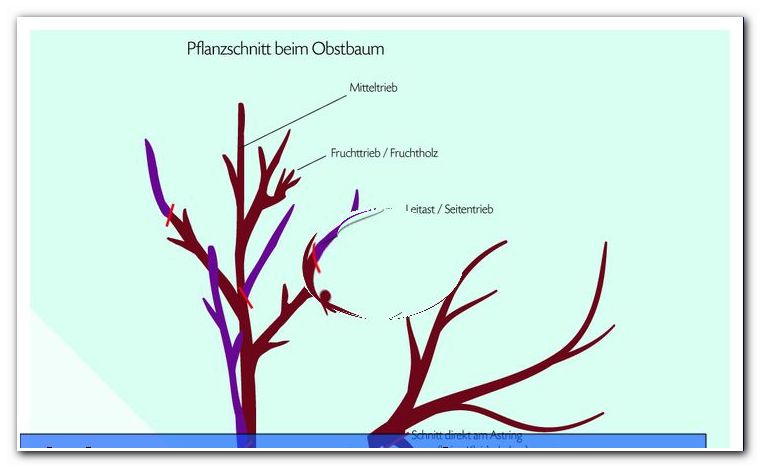
- Cut roots-bare fruit trees vigorously, adjust crown to the root
- Set the framework shape
- Shorten one center drive and three to four side scaffold drives
- Remove competition drives to the center drive
education section
Round crowns take up to seven years to complete their crown, spindle trees about three years. Until then, the parenting session will be held annually. In these years, the fruit formation is rather secondary, which does not mean that there are none. In the case of fruit trees that have a round crown as their destination, scaffolding will continue to be cut. You have to wear the whole crown and be strong for it. The drive extensions resulting from the cut must be removed if necessary. It is important not to shorten the fruit shoots sitting on the side of the scaffold shoots. They do not have to be strengthened, on the contrary, they should remain weak and apply many flower buds. Be absolutely cut off from the soil and stem growing shoots.
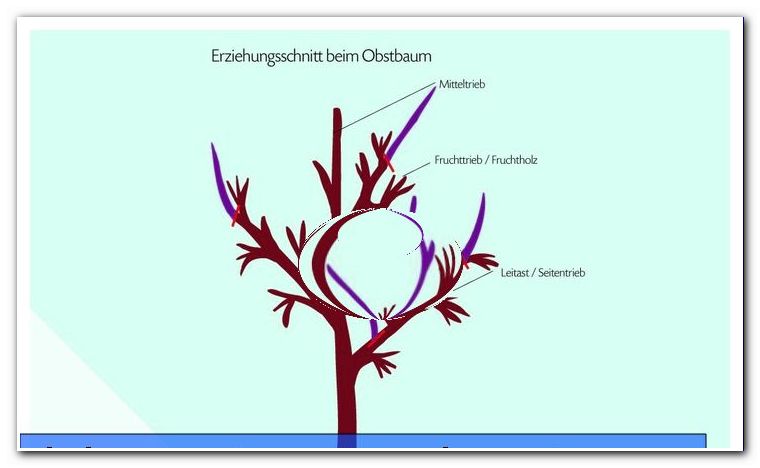
- Educational section promotes a stable framework
- Remove inward growing shoots
- In the case of round crowns scaffolding drives again shortened
- Do not shorten created side shoots, they form the fruit shoots.
- Remove drive drives at drive extension tips
preservation section
The conservation cut ensures that the fruit tree does not grow excessively and, above all, it replaces forgotten fruit wood. It provides vital fruit shoots, which carry plenty of fruit. Spindle trees and peach trees should continue to be cut every year, the other fruit trees every two to three years, especially round crowns. Delicate fruit trees are cut exclusively in summer, and growing fruit trees are added in summer.
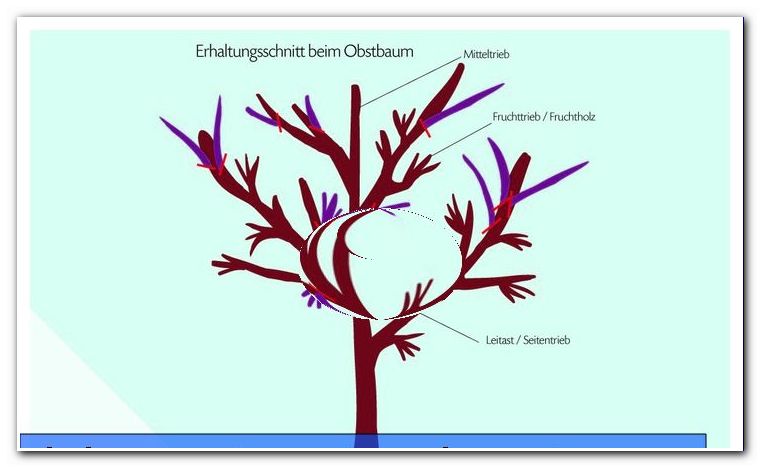
- Conservative cutting preserves the vitality of the scaffold and fruit shoots
- Slim down scaffolding tips
- Remove old fruit wood near the scaffold or divert to young shoots
rejuvenation pruning
The rejuvenation cut becomes necessary if the conservation cut is neglected. Over the years, sometimes faster, sometimes slower, the fruit shoots over age and the inside of the crown shabby. If you want to reap many fruits, you have to cut them. Depending on how long nothing has been done, more or less waste wood needs to be gone. If a lot has to be cut, it is often worth splitting the cutting measure over several years, so that the tree does not have to heal too many wounds. Forgotten shoots are completely removed. Lowering scaffold drives must be diverted to a steeper, young shoot. Then it has to be streamlined. The following year, resulting neethrates must be lighted. Cut inwards, very tightly or too steeply growing shoots at the base. Again, the shoot tips are slimmer. In the following years can be changed to the maintenance cut rhythm. So you do not have to cut every year.
- Forgotten fruit trees are made vital again
- Overhanging fruit and scaffold shoots by younger, obliquely upward growing shoots replace
- Slim down new shoot tips
Different cuts
With the different cuts you can influence where the fruit tree drives out and especially how strong it does. If you are familiar with these cuts and use them purposefully, the growth of the wood can be controlled. To cut properly, you have to follow some rules. A distinction is made between four different cutting shapes that can be used to achieve any desired goal: shortening, redirecting, slimming and trimming.
Shorten
Shortening is the simplest cut. One year old shoots are cut back in the outer area. Of course, the fruit tree is smaller after the cut, but it is not a rejuvenation. It is important that the tree retains its uniform appearance. Shortening is the cut that stimulates growth the most. That's easy to justify. The remaining buds get the full juice pressure, do not have to share it with the cut away. If this cut is done annually, it can turn negative. Then the renewal is stimulated too strong. There are too many branches and too much growth. For this reason, only in the educational phase, the scaffold drives are shortened, so they are stronger and not too long at the same time. The remaining young shoots either remain uncut or are completely removed.
- Cut back annual shoots in the outer area of the wood
- The juice jam causes numerous young shoots
- Shortening is important for strong growth
redirecting
Diverting is important in old-growth shoots, overhanging shoot tips and steeply growing shoots. The main drive is cut on a laterally rising side shoot. In overhanging shoot tips, the shoot to be diverted should always point up and out. Exactly the other way around it works when the shoot grows too steep. Here is diverted to a shoot that grows flat and also outward. The new tips absorb the increased juice pressure. At the remaining main drive it comes to a juice accumulation. This is solved by a new drive directly below the interface.
It is ideal if the shoot, which has been redirected, does not deviate too much from the growth direction of the old shoot. At almost right-angled branches continuations form over the years very strong young shoots. With almost the same continuation, the juice drive is lower, which means that the interface is almost invisible after a few years.
- By redirecting to a deeper or more inward standing shoot as a new sequel, the new shootout is weaker than when shortening
- The remaining side shoot becomes the new shoot tip
- The juice pressure ensures renewed energy
slim down
The slimming down is easier again. Here, some competing with the top shoot side shoots are removed, which is irrelevant whether it is single or perennial shoots. The goal is to make the fruit tree loose so that as much light as possible gets into the interior of the crown. Thus, the fruit shoots growing there remain vital and also consume a portion of the available energy. So not everything goes into growth. The fruit tree grows less outward and remains compact. There can be no overhanging shoots that break easily under the weight of the fruit.
Slimming is the most discreet cut. The instinctual drives are not removed or interrupted, the interfaces are hardly noticeable. In addition, only small new addition is stimulated. At the interfaces, only short neutrails are formed. It is also beneficial that even the uncut top shoots drive out only weak.
- Spur tips remain, only the side shoots are removed
- Cut with the least growth due
- The tree remains compact and vital
Thin out
Auslichten is the removal of steep or inwardly growing shoots. Actually, Auslichten refers more to berry bushes or wild fruit. When lightening whole shoots (mostly old) are removed directly on the ground to make room for new ones. These are needed for the vitality of the plants. Auslichten serves to rejuvenate shrubs. It should be noted that no pin or stub stops, from which the old shoot can drive out again. This is not a rejuvenation.
- Remove steep or inward growing shoots
incision
The incision is important for cuts to heal quickly. A proper cut with smooth wound edges will heal a cut faster. This ensures that long-lasting pathogens, bacteria or viruses can not penetrate.
Young buds
- Slightly cut off the bud at a one-year shoot for frame construction
- Do not cut too close to the bud or it will dry up.
- Do not cut too far, otherwise the stub will dry up and can not form wound tissue.
- Place the thumb of the free hand directly on the bud and cut directly over the thumbnail
Young shoots
- Each shoot has at its base a small bead, the so-called Astring. There, divisible tissue concentrates, which is important for healing.
- For young shoots, apply scissors to the top of the shoot above the bead.
- Cut slightly diagonally downwards and outwards
- Do not cut below the astring, otherwise the tissue will be cut away and the main shoot injured.
- Do not cut too horizontally, otherwise there will be a stump. This must be removed later.
Older branches
- Pre-cut thick branches. Saw about 50 cm above the intended interface from below
- Then saw 10 cm above this interface from above into the branch until it breaks off.
- The remaining Astrest will be removed last over the Astring
Cut on cones
- When large branches are diverted to more inward ones, large wounds are created. If these are larger than half the diameter of the new instar, the wound often dries back, which is not favorable.
- If the cut can not be avoided, a 10 to 20 cm long pin should be left standing.
- This pin is removed after two years, when the remaining shoot has become pretty strong. The pin is separated with an oblique cut.
- It is important to really remove the pin.
Close wounds
- Instead of a large cut, several small ones are often the better choice. That gives smaller wounds.
- In summer the cut is less dangerous for some fruit trees (cherry, walnut, plum)
- Wound closures in spring to prevent the wounds from drying.
- Are used for cutting surfaces over 5 cm in diameter
- Only thinly rub the edges of the wound, so the shoot can drive out new
- Leave wooden core free. He dries off. Pathogens can not invade
Crown shapes in fruit trees
In fruit trees can be divided into tree with trunk and round crown, with hollow crown, about spindle with trunks, trellis to pillar. Fruit trees with stem differ according to the crown shape. The shape that can be given to a fruit tree depends largely on its base, on its growth strength. So you have to know this growth power in order to be able to give the appropriate shape to a fruit tree.
Round crown Trees
The round crown is the most common form of education in fruit trees. Now and then she is also called pyramid crown. Trees that have been grafted on medium or strong growing substrates and form a trunk of one to two meters in height, are ideal for this. Such crowns claim in the adult state about 25 to 100 m². During the years of education (5 to 10) the framework is formed, consisting of a central drive and three to four evenly distributed side shoots. These remain the entire tree life exist, are initially only shortened to strengthen the scaffolding. You must later carry the entire crown plus fruit. Flat fruit shoots, which branch off from the scaffold, serve for fruit and flower formation. Unfortunately, after a few years, they are forgiven, some faster, some slower, depending on the type of fruit. Therefore, these shoots near the scaffolding must be redirected to younger ones. They are not shortened. The Conservation Cut is performed every few years and begins after the end of building the crown.
hollow crown
Hollow crowns are very similar to round crowns. With them, the center drive is removed only after two to three years. This is the only difference. The hollow crown also has up to four scaffold drives. The center drive is removed to allow as much light as possible to enter the crown. This is especially important for very warm and light-needy fruits. Typical hollow crown trees are peach and nectarine. After the removal of the central drive, again and again strong neutrails are formed. These must still be removed in the year of origin, equal to the summer.
spindle trees
Unlike the round crown, spindles grow on weak substrates. Your advantage is the small footprint. 4 m² stand space is the average space requirement per tree. Nevertheless, they bear plenty of fruit. Spindle trees are not very competitive, so they should not be constricted, especially not the root. The skeleton of a spindle consists mainly of the central drive, from which shallow fruit shoots branch off. The tree shape resembles, with the right cut course, a fir tree, narrow at the top, slightly widening down. This ensures that even the lower areas get enough light. Important for spindles is the annual cut, otherwise they are forgiving and lose their vitality. Spindle trees bear fruits after just two years. Unfortunately, they are not as old as crown trees that last for decades. Spindles are usually only 15 years old.
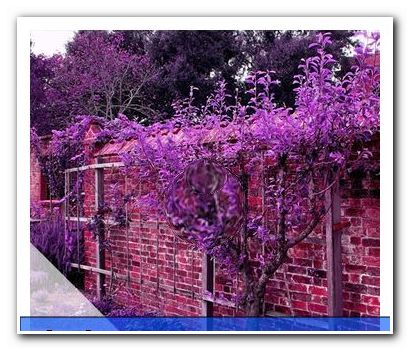
espalier
Here is the meaning, the fruit tree on a frame (usually wooden or wire frame) to educate area. Distinctions are made according to skeletal and fruit shoots, as with the other forms of education as well. Here is started directly after planting with the strict construction. All shoots, which do not serve the framework construction, are shortened on small cones. Steep shoots have to be completely out, lateral scaffolding drives are attached flat to the frame and shortened a bit. The middle drive is shortened just above the level of the second floor. Next year, the new Jungtriebe will be attached on the second floor. The trellis needs more cutting than the other tree types. The fruit shoots growing out of the scaffolding must be shortened each summer, sometimes twice, to short pins. The formation of long shoots must be suppressed. The shape of the trellis must always be clearly recognizable. A trellis needs space. Depending on education, it can grow up to 6 meters wide and 5 meters high.
Differences are some trellis forms. The most common are: the cordon, the U-palmette, the Verrier-Palmette (fan-fold) and the arch-palisade.
columnar trees 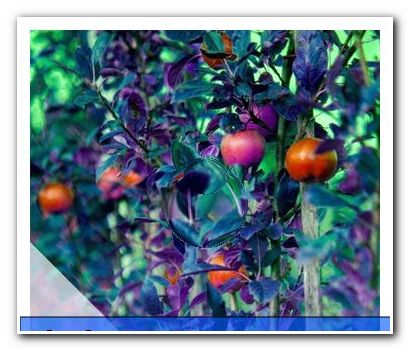
Column trees are often referred to as ballerina trees. They consist of a dominant central drive and short side branches. These short shoots form the fruit wood. There is little need to cut the columns. In principle, only from time to time resulting competitive drives of the center are to be removed. The side shoots do not have to be cut away. After a few years, the tree is overgrown. Then he is simply cut back by half. Of the emerging from the interface young drives one is left as a new center. The rest are removed. Cut chopped or overly branched fruit shoots on short cones. From this new growths grow again. Inward growing or too long weak shoots are removed, which remain short, strong as new fruit shoots.


